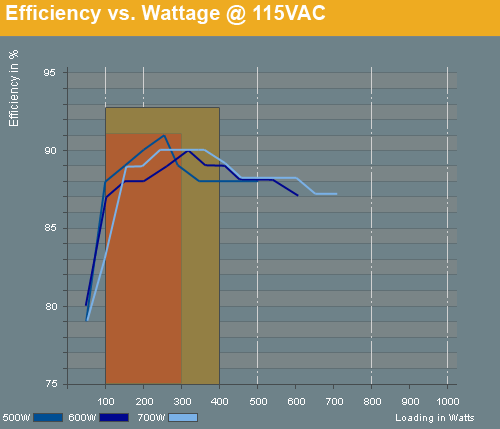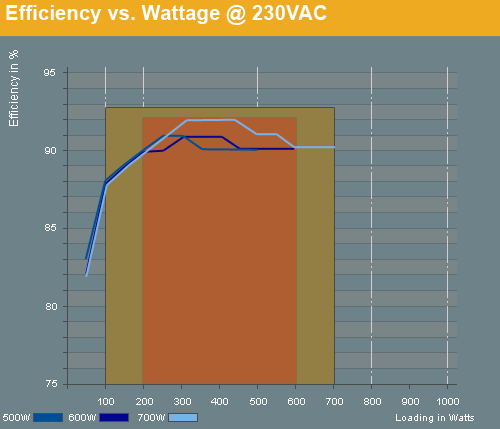Enermax Gold: Modu87+ and Pro87+
by Christoph Katzer on January 19, 2010 1:00 PM EST- Posted in
- Cases/Cooling/PSUs
Efficiency Comparison and How to Choose Your PSU
We wanted to explain to you how much power your system should actually use so you can make the best use of your new power supply. Of course you can load these power supplies up to the limit and still have around 87% efficiency - a result that many cheaper power supplies cannot reach even at their ideal load. However, these graphs show you where these power supplies reach their best efficiency.

From 100 to around 400W you will get maximum efficiency if you're on a 115VAC grid. That will provide you with an 88-91-88-percent curve with the 500W unit, an 87-90-89-percent curve with the 600W unit, and an 83-90-89-percent curve with the 700W unit. If you want even better efficiency you would want to be in the darker red area of 100 to 300W output. We've combined all three PSUs on one chart, however, so you will want to consider the curves and adjust your PSU selection as appropriate, e.g. the 700W PSU performs best with a load of at least 150W.

With 230VAC our recommendations look quite different. Users on a 230VAC grid can use any of these three units with any kind of load and achieve very good efficiency. Even at 5% load all of the units are still well above 80%, which is something that was difficult to reach a few years back. If you really want to squeeze the best results out of your units you will want load of at least 100W up to the maximum rated output of the PSU. That is a very large area and it shows how versatile these PSUs are. If your system uses 200W to 600W you will be able to maintain a constant efficiency of over 90%! In short, hook up just about any system to these power supplies on a 230V grid and you can be sure you'll be truly energy efficient.
Just to put things in perspective, the 80 Plus certification was introduced a few years back to put public focus on more energy efficient products, mainly power supplies. In the beginning there was only one certification, but since the initial introduction the group behind the certification has felt it necessary to introduce additional levels of efficiency. Today, we have Bronze, Silver, and Gold, with Gold being the highest level of the 80 Plus and presenting a very difficult target for the PSU manufacturers. The race to Gold has now been won, but now there's a new target in sight: Platinum. The required efficiencies for the different levels are listed below.
| 80 Plus Certification Requirements | |||
| 20% Load (Light) | 50% Load (Typical) | 100% Load (Full) | |
| 80 Plus Standard | 80% | 80% | 80% |
| 80 Plus Bronze | 82% | 85% | 82% |
| 80 Plus Silver | 85% | 88% | 85% |
| 80 Plus Gold | 87% | 90% | 87% |
| 80 Plus Platinum (230VAC only) | 90% | 94% | 91% |










59 Comments
View All Comments
strikeback03 - Wednesday, January 20, 2010 - link
Probably because over 90% of the computers that exist are built by OEMs, and a high quality power supply is too expensive for that application. You are going to have a hard time selling consumers on "higher quality power" when that is something they expect to just work.7Enigma - Wednesday, January 20, 2010 - link
A patent on a 140mm fan? Seriously? What a load of crap. They should have made the 139mm 139.9mm and put a big red F in their booklet with the name of the patent-holder. What is this world coming to?7Enigma - Wednesday, January 20, 2010 - link
I have to say I am very pleased with the modular PSU's sticking with the same plug design. That would make cable management after installation a thing of the past which I think for 90% of us DIY builders is what keeps us from replacing a PSU mid-upgrade cycle. Instead just disconnect the cables from the old PSU, pop in the new one, and connect the cables again.I do want to mention a PSU I installed for my cousin about a month ago. I for the life of me can't remember the brand but it was definitely a high-end PSU. It was modular and instead of using the typical A/C plug style to connect the cables to the PSU, it had similar to a microphone plug; 3 pronged in a triangle fashion with a locking collar that you had to screw down. It was a VERY well manufactured piece and there was no issue with feeling the connection wasn't solid.
Anyways glad to see a PSU review again. I got burned a year ago when I jumped the gun on an early recommendation for a PSU you were just starting to test and have been unhappy with its rails and overall quality (Tuniq Potency). Penny-wise, pound-foolish and all. I've been trying to justify upgrading to a better PSU and I think the time has just about come. I just hate the though of doing the cable management again...definitely going to be getting a modular PSU again (previous to the Tuniq I had an Antec NeoPower 480w which was awesome in its day).
dukeariochofchaos - Wednesday, January 20, 2010 - link
the best i can find these for is ~$240 for the 600watt, and ~$275 for the 700watt.so far, i can't find the 500, or any of the "pro" series.
i guess they figure somebody spending that much on a psu is only going for the top.
Christoph Katzer - Wednesday, January 20, 2010 - link
Yes, unfortunately Enermax USA won't take all of these six units.strikeback03 - Wednesday, January 20, 2010 - link
So does that mean we won't see the 500W units?Well, at least there is still Seasonic.
Christoph Katzer - Wednesday, January 20, 2010 - link
I heard they will be bringing the Pro87+ 500 & 600W.dukeariochofchaos - Tuesday, January 26, 2010 - link
i have seen these come down in price in akihibara already.in the right places, they are ~$200 for the 600w, and ~$230 for the 700w.
i have also seen the "pro" models around for about $50 less for each.
cupoftea - Wednesday, January 20, 2010 - link
I meant first paragraph.Hoist. Petard.
cupoftea - Wednesday, January 20, 2010 - link
Pedant ON. Its not a square shape its an octagon, to match the octagonal hole for the fan and (most) of the metalwork forming the fan guard. Pedant OFF.